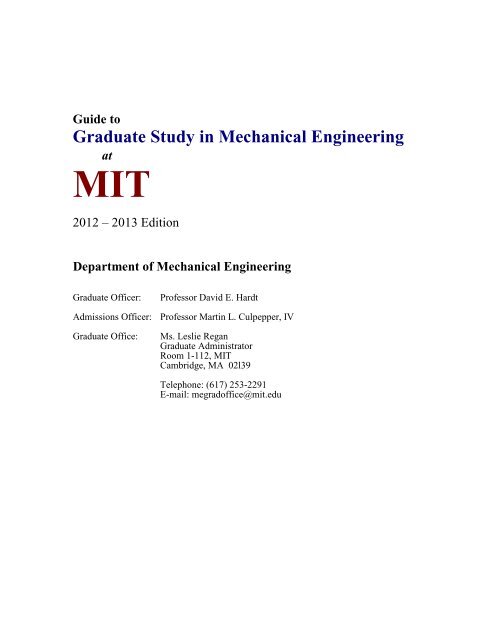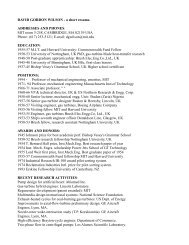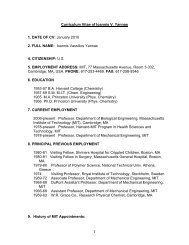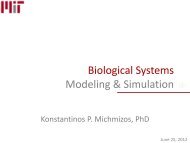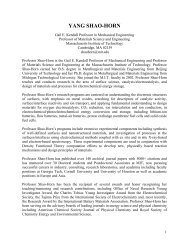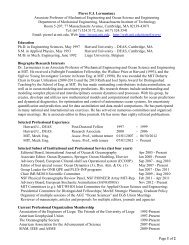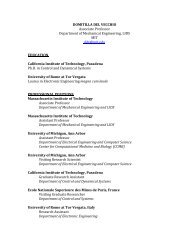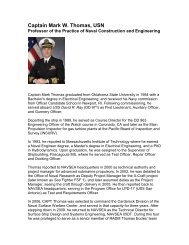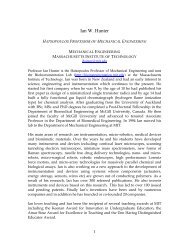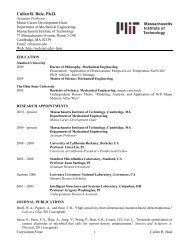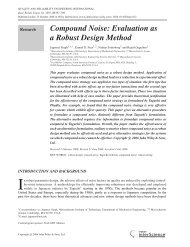Guide To Graduate Study In Mechanical Engineering - MIT
Guide To Graduate Study In Mechanical Engineering - MIT
Guide To Graduate Study In Mechanical Engineering - MIT
You also want an ePaper? Increase the reach of your titles
YUMPU automatically turns print PDFs into web optimized ePapers that Google loves.
<strong>Guide</strong> to<br />
<strong>Graduate</strong> <strong>Study</strong> in <strong>Mechanical</strong> <strong>Engineering</strong><br />
at<br />
<strong>MIT</strong><br />
2012 – 2013 Edition<br />
Department of <strong>Mechanical</strong> <strong>Engineering</strong><br />
<strong>Graduate</strong> Officer: Professor David E. Hardt<br />
Admissions Officer: Professor Martin L. Culpepper, IV<br />
<strong>Graduate</strong> Office: Ms. Leslie Regan<br />
<strong>Graduate</strong> Administrator<br />
Room 1-112, <strong>MIT</strong><br />
Cambridge, MA 02l39<br />
Telephone: (617) 253-2291<br />
E-mail: megradoffice@mit.edu
Contents<br />
1. The <strong>Graduate</strong> Program in <strong>Mechanical</strong> <strong>Engineering</strong> 3<br />
2. Entrance Requirements 4<br />
3. Admission 4<br />
4. Writing Ability 4<br />
5. Master of Science Degrees 5<br />
Credit units 5<br />
Thesis 5<br />
Distribution requirements 6<br />
Double SM degrees 7<br />
6. Master of Science <strong>Engineering</strong> in Manufacturing 7<br />
7. <strong>Mechanical</strong> Engineer's Degree 8<br />
Program of courses 8<br />
Thesis 9<br />
Qualifying examination 9<br />
8. Naval Engineer's Degree 9<br />
Program of courses 9<br />
Thesis 10<br />
Qualifying examination 10<br />
9. Doctoral Program 10<br />
Writing ability requirement 11<br />
Qualifying examination 11<br />
Major 12<br />
Minor 12<br />
Thesis 13<br />
Rules of the doctoral program 13<br />
10. Financial Support and Thesis Supervision 15<br />
Types of financial aid available 15<br />
How to get a research assistantship or teaching assistantship 15<br />
How to find a thesis supervisor if you have independent funding 16<br />
Requirements for students who perform thesis work off-campus,<br />
or spend terms off-campus 16<br />
2
1. The <strong>Graduate</strong> Program in <strong>Mechanical</strong> <strong>Engineering</strong><br />
The <strong>Graduate</strong> Program brings together faculty members and post-baccalaureate students into a<br />
community of scholars with a common interest in innovation, creativity and advanced<br />
professional study. It seeks to provide, in the atmosphere of a professional school, the widest<br />
possible opportunity for advanced study and investigation and for intimate association among<br />
workers whose common objective is to extend the boundaries of their profession.<br />
The <strong>Mechanical</strong> <strong>Engineering</strong> Department offers the following graduate degrees: 1<br />
(1) Master of Science in <strong>Mechanical</strong> <strong>Engineering</strong> (SMME)<br />
(2) Master of Science in Ocean <strong>Engineering</strong> (SMOE)<br />
(3) Master of Science in Naval Architecture and Marine <strong>Engineering</strong> (SMNAME)<br />
(4) Master of Science in Oceanographic <strong>Engineering</strong> (SMOGE, joint <strong>MIT</strong>/WHOI degree)<br />
(5) Master of <strong>Engineering</strong> in Manufacturing<br />
(6) <strong>Mechanical</strong> Engineer's (ME) degree<br />
(7) Naval Engineer's (NE) degree<br />
(8) Doctor of Philosophy (PhD) or Doctor of Science (ScD), which differs in name only;<br />
(this includes the joint <strong>MIT</strong>/WHOI degrees)<br />
A Master of Science degree is the first graduate degree offered in ME. It is awarded for the<br />
completion of a program of advanced study, and a thesis which is considered to be the<br />
centerpiece of a student's graduate experience.<br />
The Master of <strong>Engineering</strong> in Manufacturing is a one-year professional degree program that<br />
prepares the student to assume a role of technical leadership in the manufacturing industries.<br />
The Engineer's degree offers preparation for a career in advanced engineering practice. It<br />
does so through a program of advanced coursework which goes well beyond the Master's level.<br />
This degree is not a stepping stone toward the PhD.<br />
The Doctor of Philosophy (or Science) is the highest academic degree offered. It is awarded<br />
for the completion of a program of advanced study and a significant original thesis.<br />
<strong>In</strong> what follows, we describe how students can gain entry to the ME graduate programs<br />
(sections 2 and 3) and what they must accomplish to obtain the various degrees (sections 4-9).<br />
Section 10 describes some of the means available at <strong>MIT</strong> to support graduate students<br />
financially.<br />
1 Students admitted in or before fall 2005 to the 13B program in Ocean Systems Management will be able to pursue<br />
their degree objectives at the SM or Doctoral level according to the old Ocean <strong>Engineering</strong> Department regulations.<br />
Their diplomas and degrees will be recommended by the Department of Ocean <strong>Engineering</strong> following the <strong>MIT</strong><br />
Bulletin for academic year 2004-2005.<br />
3
2. Entrance Requirements<br />
Applications to the <strong>Mechanical</strong> <strong>Engineering</strong> <strong>Graduate</strong> School are accepted from persons who<br />
have completed, or will have completed by the time they arrive, a Bachelor's degree. Most<br />
incoming students will have a degree in mechanical engineering, ocean engineering, or some<br />
related branch of engineering. However, the department's admission criteria are not specific, and<br />
capable students with backgrounds in different branches of engineering or in science may gain<br />
entry.<br />
<strong>To</strong> qualify for a graduate degree, applicants are expected to have at least an undergraduatelevel<br />
exposure to most of the core ME disciplines (applied mechanics, fluid mechanics,<br />
thermodynamics and heat transfer, materials, control, design and manufacturing), and to be<br />
familiar with basic electric circuits and electromagnetic field theory. Those who are deemed<br />
deficient may be asked to make up courses in certain areas before they graduate. The makeup<br />
courses may be at the undergraduate level, in which case they are relatively elementary, but<br />
usually cannot be applied toward graduate credit, or at the graduate level, in which case they<br />
carry graduate credit.<br />
3. Admission<br />
The method to apply to the <strong>Mechanical</strong> <strong>Engineering</strong> <strong>Graduate</strong> Program is via our Online<br />
system.<br />
All official transcripts must be submitted directly to the ME <strong>Graduate</strong> Office, Room 1-112,<br />
M.I.T., 77 Massachusetts Avenue, Cambridge, MA 02139<br />
The processing of the applications for graduate study in <strong>Mechanical</strong> <strong>Engineering</strong> is done<br />
entirely by the Department. The departmental admissions officer, together with a faculty<br />
committee, reviews all applications, rank-orders them, and admits the number of applicants that<br />
the department expects it can accommodate.<br />
Foreign students applying from abroad may be admitted, but are not permitted to register<br />
unless they have full financial support for at least the first year. For most of them this support<br />
comes from their family, their government, or some fund or fellowship. Some may, however,<br />
become eligible for registration by receiving an offer of a research or teaching assistantship from<br />
an individual professor (see section 10).<br />
All applicants are required to take the General Exam part of the <strong>Graduate</strong> Record<br />
Examination (GRE) and submit their scores. Students from non-English-speaking countries are<br />
also required to take the IELTS (preferred) or the TOEFL exam. Students whose citizenship is<br />
from <strong>In</strong>dia are exempt from taking the IELTS or TOEFL exam. The minimum acceptable scores<br />
for the IELTS exam is 7.0 and for the TOEFL exam, it is 90 (ibt), 233 (cbt) or 577 (pbt).<br />
Applications are due by December 15 of the previous year, and decisions are reported in<br />
March.<br />
4. Writing Ability<br />
All incoming graduate students must demonstrate satisfactory English writing ability, or<br />
successfully complete appropriate training in writing. This requirement reflects the faculty's<br />
conviction that writing is an essential skill for an engineer with an advanced degree.<br />
All incoming graduate students, native as well as foreign, must take the <strong>In</strong>stitute writing<br />
ability test which is administered in September. Depending on the results, a student will either<br />
(a) pass the writing ability requirement, (b) be required to take a relatively short, but intensive,<br />
seminar-workshop in expository writing during the <strong>In</strong>dependent Activities Period in January<br />
4
(21W.794 Technical Writing Workshop), or (c) be required to take a course in writing. Several<br />
courses suitable for engineers and scientists are offered at <strong>MIT</strong>, and special courses are available<br />
for those for whom English is a second language.<br />
Note that all graduate students for whom English has not been the language of instruction in both<br />
elementary and secondary school are also required by <strong>MIT</strong> to take an English Evaluation Test.<br />
This test is separate from the departmental writing ability test.<br />
5. Master of Science Degrees<br />
Writing ability requirement. All incoming graduate students are subject to the writing ability<br />
requirement, which is described in section 4.<br />
There are three additional requirements for Master of Science degrees offered by the Department.<br />
These pertain to (1) credit units, and (2) thesis. The three Ocean-related Master’s degrees also<br />
have (3) a distribution requirement. The SMME degree does not have a distribution requirement.<br />
The specific requirements are as follows:<br />
5.1. Credit units<br />
• Students must successfully complete at least 72 credit units of coursework, not including<br />
credit received for thesis work. Of the 72 units of required coursework, at least 48 must<br />
be H-level graduate subjects. The remaining 24 units may be for G-level subjects, or for<br />
certain advanced undergraduate subjects that are not requirements in <strong>MIT</strong>’s<br />
undergraduate <strong>Mechanical</strong> <strong>Engineering</strong> curriculum.<br />
• The program is expected to include at least three H-level graduate Course 2 subjects<br />
(36 units).<br />
• Students must take at least one graduate mathematics subject (12 units) offered by the<br />
Mathematics Department at <strong>MIT</strong>. No waivers are allowed.<br />
• A minimum grade point average of 3.5 (A=5, B=4, C=3, D=2, F=0) must be maintained<br />
in graduate school.<br />
• Students are allowed to transfer credit toward their Master's degree from graduate<br />
subjects taken previously at <strong>MIT</strong> or another accredited institution, and not used as part of<br />
the credits required for an undergraduate or graduate degree. The limit is 24 credit<br />
units if the subjects were taken outside <strong>MIT</strong>. Transferred subjects must have a grade of<br />
B or higher. No thesis units may be transferred.<br />
5.2. Thesis<br />
<strong>In</strong> the ME Department, the thesis is considered to be the centerpiece of a student's<br />
graduate experience. The student must complete an acceptable SM thesis under the<br />
supervision of an <strong>MIT</strong> faculty member or a Senior/Principal Research Scientist/Engineer<br />
who holds an appointment in the <strong>Mechanical</strong> <strong>Engineering</strong> Department. The thesis is an<br />
original work of research, design, or development. The supervisor signs and accepts the<br />
thesis upon completion.<br />
If the supervisor is not a member of the <strong>Mechanical</strong> <strong>Engineering</strong> Department, a reader<br />
who belongs to the <strong>Mechanical</strong> <strong>Engineering</strong> faculty must also endorse the thesis.<br />
Entering Master's degree candidates<br />
5
• must notify the ME <strong>Graduate</strong> Office of their thesis supervisor within six weeks of<br />
registration, and<br />
• must submit a completed thesis by a due date set by <strong>MIT</strong>, typically no later than<br />
one week before the beginning of the examination period.<br />
5.3. Distribution Requirements for the Ocean-related Master’s Degrees<br />
• Master of Science in Ocean <strong>Engineering</strong>: (A graduate subject in each area is<br />
required.) (i) Marine Hydrodynamics (2.20); (ii) A subject that emphasizes<br />
professional practice in ocean environment, such as Design Principles for Ocean<br />
Vehicles (2.22); and (iii) A subject in Acoustics and Sensing (e.g. 2.066), or Structural<br />
Mechanics (e.g. 2.080J), or Structural Dynamics (e.g. 2.060J).<br />
• Master of Science in Naval Architecture and Marine <strong>Engineering</strong>: (i) Marine<br />
Hydrodynamics (2.20 or a more advanced subject); and (ii) at least 24 units in their<br />
area of concentration. (Background requirements in <strong>In</strong>troduction to Naval Architecture<br />
(e.g., 2.701), and Ship Power and Propulsion (e.g., 2.611) can be waived if taken as an<br />
undergraduate; otherwise, these subjects need to be taken at <strong>MIT</strong>.)<br />
• Master of Science in Oceanographic <strong>Engineering</strong>: Page 7 of the Joint Program<br />
Handbook for Oceanographic <strong>Engineering</strong> list requirements for Master of Science.<br />
(Please note that this handbook is currently undergoing revisions)<br />
6<br />
* * *<br />
A typical Master's degree consists of six twelve-unit subjects plus a thesis, and takes a<br />
fulltime student three regular (fall and spring) terms to complete. Students with a research<br />
assistantship will not be able to finish in less than this time because of the limitation on the<br />
number of subjects they are allowed to take per term (see section 11). At the same time, there is<br />
no reason, other than the uncertainties of research, why they should take longer. The faculty<br />
believes that a typical Master's degree in <strong>Mechanical</strong> <strong>Engineering</strong> should not take longer than one<br />
and a half years (three full terms plus the intervening summer) and will strive to implement this<br />
duration in its graduate program.<br />
<strong>In</strong> the ME Department the thesis is considered to be the centerpiece of a student's graduate<br />
experience. The Master's thesis is essentially a research (or development, or design)<br />
apprenticeship under a faculty supervisor, and as such is usually the major contributor to the<br />
student's professional maturation. <strong>In</strong>coming students are urged to find a thesis project and<br />
supervisor without undue delay. There are several reasons for avoiding delay. For one thing, the<br />
SM thesis is a substantial piece of work and takes time to mature. For another, a student who<br />
begins thesis work associates him/herself not only with a faculty member, but usually also with a<br />
research group or laboratory where he/she meets other faculty and experienced graduate students<br />
from whom to learn and get good advice. It is usually a mistake to think that the degree can be<br />
attained more efficiently by taking the coursework first, and putting off the thesis work to the last<br />
term.<br />
A student's thesis supervisor usually also serves as the academic advisor. If the thesis<br />
supervisor is not a <strong>Mechanical</strong> <strong>Engineering</strong> Department faculty member, the student should seek<br />
academic advice from an ME faculty member whose research interests are close to his/her own<br />
(such as the departmental thesis reader), or from the graduate officer.
5.4. Double SM degrees.<br />
• Students registered in another engineering department at <strong>MIT</strong> who wish to earn a<br />
Master of Science in <strong>Mechanical</strong> <strong>Engineering</strong>, Ocean <strong>Engineering</strong>, Naval Architecture<br />
and Marine <strong>Engineering</strong>, or Oceanographic <strong>Engineering</strong> simultaneously with a Master's<br />
degree with specification in their own department may do so by satisfying both<br />
departments' requirements, with the credit unit requirements satisfied separately (see the<br />
<strong>MIT</strong> <strong>Graduate</strong> School Manual), but with a common thesis. Such programs of study must,<br />
however, be approved in advance by the graduate admissions officers of both the<br />
departments involved. The ME Department’s procedural requirements are the following:<br />
(i) The application form for the dual master’s degree in the ME Department must be filled<br />
out, and adhered to. The student must be admissible to the ME Department. (ii) The<br />
student must select an ME faculty member as a thesis reader. That faculty member must<br />
accept the responsibility by a letter to the ME <strong>Graduate</strong> Admissions Officer. (iii) Items<br />
(i) and (ii) must be completed well in advance of thesis completion, but no later than June<br />
1 of the year before the student expects to graduate.<br />
• Students registered in <strong>Mechanical</strong> <strong>Engineering</strong> who wish to earn a Master of Science in<br />
<strong>Mechanical</strong> <strong>Engineering</strong> simultaneously with the Ocean-<strong>Engineering</strong> Master’s degrees<br />
offered by the Department may do so by satisfying requirements for both degrees: 144<br />
credit units (at least 96 at the graduate H-level), but with a common thesis. Such<br />
programs of study must, however, be approved in advance by the ME <strong>Graduate</strong><br />
Admissions Officer. The ME Department’s procedural requirements are the following:<br />
(i) The application form for the dual master’s degree in <strong>Mechanical</strong> <strong>Engineering</strong> must be<br />
filled out, and adhered to. (ii) The ME faculty member who serves as the thesis advisor<br />
must accept the responsibility by a letter to the ME <strong>Graduate</strong> Admissions Officer, and<br />
ensure that all requirements for the dual degree are met. Items (i) and (ii) must be<br />
completed well in advance of thesis completion, but no later than June 1 of the year<br />
before the student expects to graduate.<br />
6. Master of <strong>Engineering</strong> in Manufacturing<br />
The Master of <strong>Engineering</strong> in Manufacturing is a one-year professional degree program<br />
that is intended to prepare the student to assume a role of technical leadership in the<br />
manufacturing industries. The degree is aimed at practitioners who will use this knowledge<br />
to become leaders in existing as well as emerging manufacturing companies. The curriculum<br />
consists of (i) a highly integrated set of 7 lecture/laboratory-based subjects, and a professional<br />
seminar for a total of 90 credit units (not including credit received for thesis work); (ii) a<br />
thesis project for 24 credit units; and (iii) writing ability. A minimum grade point average of<br />
3.5 must be maintained in graduate school. The following subjects are required, however,<br />
exceptions can be made with approval of the M.Eng. in Manufacturing coordinator.<br />
1. The core subject areas are (90 units):<br />
• Manufacturing Physics (3 subjects): Manufacturing Materials and Processes<br />
(2.810), Analysis Design and Control of Automated Equipment (2.168),<br />
Process Optimization and Control (2.830)<br />
• Manufacturing Systems (3 subjects): <strong>In</strong>troduction to Manufacturing Systems<br />
(2.853); Supply Chain Planning and Design (15.762+15.763);<br />
7
• Business Fundamentals: Management for Engineers (2.891)<br />
• Plus 1 of the following: Product Design and Development (2.739J), Product<br />
Design (2.744); Precision Machine Design (2.75); Axiomatic Design (2.882);<br />
Assembly and Product Design (2.875J)<br />
2. Professional Seminar in Emerging Manufacturing <strong>In</strong>dustries<br />
3. Thesis Project (24 units) The thesis project is intended to give each student<br />
experience in a manufacturing industry, working on problems with both strategic<br />
breadth and technical depth. It is an integrating experience to help pull together the<br />
diverse topics treated in class. The projects will explore innovations in technology,<br />
systems and business strategy<br />
7. <strong>Mechanical</strong> Engineer's Degree<br />
The <strong>Mechanical</strong> Engineer's degree provides an opportunity for further study beyond the Master's<br />
level for those who wish to enter engineering practice rather than research. This degree<br />
emphasizes breadth of knowledge in mechanical engineering and its economic and social<br />
implications, and is quite distinct from the PhD, which emphasizes depth and originality of<br />
research. The <strong>Mechanical</strong> Engineer's degree is not a stepping stone toward the PhD.<br />
The Engineer's degree has four requirements: (1) writing ability, (2) a program of<br />
coursework, (3) thesis, and (4) a qualifying examination. These are described below.<br />
Program of courses. The subject requirements are as follows:<br />
(1) 162 credit units (including credited units taken during the Master's degree program).<br />
(2) At least 120 units (including 2.999 - see below) must be graduate H-level subjects.<br />
(3) At least one subject from eight of the following ten areas:<br />
a. Mechanics of Solids f. Design<br />
b. Materials g. Manufacturing<br />
c . Fluid Mechanics h. Nanotechnology<br />
d. Thermodynamics/Heat transfer i. Energy<br />
e. System Dynamics & Control h. Bioenegineering<br />
(4) A management/economics requirement of one subject as approved by the Engineer's Degree<br />
Subcommittee.<br />
Students entering the <strong>Graduate</strong> School with a Master's degree are permitted to transfer no<br />
more than 24 units from another school to the <strong>MIT</strong> record. No thesis units may be transferred.<br />
Subjects being transferred to <strong>MIT</strong> records should have a grade of B or higher.<br />
Thesis. The thesis may be an extension of a suitable applications-oriented<br />
SMME/SOME/SMNAME/SMOGE thesis, or it may be a separate piece of work. An important<br />
requirement is that the thesis deal with the solution of real, practical engineering problems,<br />
including both their technical and socio-economic aspects. Students are required to submit a<br />
specific thesis proposal to the Engineer's Degree Subcommittee shortly after embarking on the<br />
program. Students who enter the program with an SM degree from another school must do a<br />
separate Engineer's thesis.<br />
Students who do a separate Engineer's thesis, or who are required to extend a previously<br />
submitted <strong>MIT</strong> SMME/SOME/SMNAME/SMOGE thesis, may receive up to a maximum of 12<br />
8
units of credit for their work. The student's thesis advisor determines the amount of credit.<br />
Credit is received by registration of the thesis work as subject 2.999. The credit units for 2.999,<br />
not exceeding 12 units, become part of the 162 units total subject requirement.<br />
Qualifying examination. Candidates should take the Engineer's Degree qualifying examination<br />
during their first year of residence. These exams are given by the Engineer's Degree<br />
Subcommittee, usually in January and May. The examination is an oral one in which the<br />
students make a twenty-minute presentation of their thesis proposal and work to date, placing<br />
approximately equal emphasis on the technical aspects of the work and on its usefulness in<br />
engineering applications in general. Questions on the thesis and related areas will be asked, and<br />
the Subcommittee will render its judgment based on both the technical content of the work and<br />
its utility in engineering practice.<br />
The qualifying examination for the Engineer’s Degree may be waived for candidates with<br />
either 3 years military or 5 years industrial post-Bachelor’s Degree experience, and with<br />
concurrence from the <strong>Graduate</strong> Officer.<br />
The overall course of study and thesis must comprise a coherent program in <strong>Mechanical</strong><br />
<strong>Engineering</strong>. The candidate is required to prepare a plan of study and to submit it to the<br />
<strong>Graduate</strong> Officer for approval by the Engineer's Degree Subcommittee. The student will be<br />
considered an Engineer's Degree candidate when this plan is approved.<br />
8. Naval Engineer's Degree<br />
Naval <strong>Engineering</strong> is considered to include all the arts and sciences as applied in the design,<br />
construction and operation of surface and sub-surface marine vehicles. The Naval Engineer’s<br />
Degree provides an opportunity for further study beyond the Master’s level and is intended for<br />
those who wish to enter engineering practice, or who plan a career in the design, acquisition,<br />
repair and modernization of ships and ship systems. This degree emphasizes breadth of<br />
knowledge in naval engineering and is quite distinct from the PhD, which emphasizes depth and<br />
originality of research.<br />
Requirements for the Naval Engineer’s Degree are identical to those for the <strong>Mechanical</strong><br />
Engineer’s Degree outlined in Section 7 above, with the following differences:<br />
Program of courses. The subject requirements are as follows:<br />
(1) 162 credit units, including credited units taken during the Master’s Degree program.<br />
(2) At least 120 units (including 2.999, see below) must be graduate H-level subjects.<br />
(3) At least one subject from eight of the following eleven areas:<br />
(Subjects from various <strong>MIT</strong> departments are normally taken to satisfy this requirement.)<br />
a. Mathematics & Numerical Methods g. Structural Mechanics<br />
b. Dynamics h. Acoustics<br />
c. Hydrodynamics i. Ship Production<br />
d. Materials & Fabrication Technology j. Naval Architecture & Systems Eng<br />
e. Power and Propulsion k. Ship Design<br />
f. Probability & Statistics<br />
(4) Ship design is an integral part of the Naval Engineer’s Degree curriculuum. Candidates are<br />
required to complete both a conversion design project (2.074) and a 24-credit <strong>MIT</strong> new major<br />
design project (2.705) during their course of study.<br />
9
Thesis. The thesis may be an extension of a suitable applications-oriented<br />
SMME/SOME/SMNAME/SMOGE thesis, or it may be a separate piece of work. An important<br />
requirement is that the thesis deal with the solution of real, practical engineering problems,<br />
including both their technical and socio-economic aspects. Students are required to submit a<br />
specific thesis proposal to the Naval Engineer's Degree Subcommittee shortly after embarking on<br />
the program. Students who enter the program with an SM degree from another school must do a<br />
separate Engineer's thesis.<br />
Students who do a separate Engineer's thesis, or who are required to extend a previously<br />
submitted <strong>MIT</strong> SMME/SOME/SMNAME/SMOGE thesis, may receive up to a maximum of 12<br />
units of credit for their work. The student's thesis advisor determines the amount of credit.<br />
Credit is received by registration of the thesis work as subject 2.999. The credit units for 2.999,<br />
not exceeding 12 units, become part of the 162 units total subject requirement.<br />
Qualifying examination.<br />
Candidates should take the Naval Engineer's Degree qualifying examination during their first<br />
year of residence. These exams are given by the Naval Engineer's Degree Subcommittee, usually<br />
in January and May. The examination is an oral one in which the students make a twenty-minute<br />
presentation of their thesis proposal and work to date, placing approximately equal emphasis on<br />
the technical aspects of the work and on its usefulness in engineering applications in general.<br />
Questions on the thesis and related areas will be asked, and the Subcommittee will render its<br />
judgment based on both the technical content of the work and its utility in engineering practice.<br />
The qualifying examination for the Naval Engineer’s Degree may be waived for candidates<br />
with either 3 years military or 5 years industrial post-Bachelor’s Degree experience, and with<br />
concurrence from the <strong>Graduate</strong> Officer.<br />
The overall course of study and thesis must comprise a coherent program in naval<br />
engineering. The candidate is required to prepare a plan of study and to submit it to the <strong>Graduate</strong><br />
Officer for approval by the Engineer's Degree Subcommittee. The student will be considered an<br />
Engineer's Degree candidate when this plan is approved.<br />
9. Doctoral Program<br />
The highest academic degree is the Doctor of Science, or Doctor of Philosophy. At <strong>MIT</strong>, these<br />
degrees differ in name only. The doctorate is awarded upon the completion of a program of<br />
advanced study, principally at the <strong>In</strong>stitute, and the performance of significant original research,<br />
design or development.<br />
Admission into the doctoral program<br />
1. Students from outside <strong>MIT</strong> may apply to the doctoral program if they have a Master of<br />
Science degree.<br />
2. Those who are in the departmental SM program may in principle apply at any time, but<br />
they must do so before they receive their SM if they expect to continue on without<br />
interruption. 2 The deadline is March 1 for students on the June/September degree list,<br />
2 An application to the doctoral program by an existing SM student implies that the student intends to continue his<br />
graduate studies without interruption. If admitted, no immediate (formal or informal) leave of absence/deferment<br />
will be granted, and the time for taking the Doctoral Qualifying Examinations will be the same as that for an<br />
incoming student with an SM degree from another institution.<br />
10
and November 1 for those on the January degree list. All internal applications should<br />
include:<br />
• Transcripts; a minimum GPA of 4.5 is required. Applicants with a GPA below 4.5<br />
may be considered for admission if they present evidence of outstanding potential to<br />
carry out independent research.<br />
• At least two letters of reference from faculty (one from the SM thesis advisor).<br />
• A statement of objectives.<br />
• Applications should be submitted to the Departmental <strong>Graduate</strong> Office, Room 1-112.<br />
Note that the qualifying examinations must be taken within three regular terms of the<br />
date of admission to the doctoral program (see below).<br />
Requirement for the doctoral degree<br />
The five basic requirements for the doctorate in mechanical engineering are:<br />
(1) the writing ability requirement, which all graduate students must satisfy,<br />
(2) the doctoral qualifying examination,<br />
(3) a major program of advanced study,<br />
(4) a minor program of study in a field different from that of the major, and<br />
(5) a thesis.<br />
Details of the five basic requirements are given below, followed by the rules (procedure,<br />
schedules, etc.) which pertain to the doctoral program.<br />
Writing ability requirement. All incoming graduate students are subject to the writing ability<br />
requirement, which is described in section 4.<br />
Qualifying examinations. The purpose of the qualifying examinations is to determine whether<br />
the applicant possesses the attributes of a doctoral candidate: mastery of the mechanical/ocean<br />
engineering disciplines and ingenuity and skill in identifying and solving unfamiliar problems.<br />
The qualifying examinations are offered twice yearly (January and May) during a two-week<br />
period. All students who are admitted to the doctoral program are eligible to take the qualifying<br />
exams, and must do so (for the first time) before the end of three regular terms (fall and spring)<br />
after admission to the PhD program. There will be no exceptions, except by prior petitioning to<br />
the <strong>Graduate</strong> Officer under special circumstances.<br />
The qualifying examinations consist of two parts:<br />
1. A set of three subject area examinations which candidates may choose from the following<br />
approved list (in parenthesis the subject or subjects most suitable for preparation for these<br />
exams are included):<br />
• Dynamics (2.032) or Acoustics (2.066)<br />
• Mechanics of Solid Materials (2.002, 2.071), or Structural Mechanics<br />
(2.080J)<br />
• Fluid Mechanics (2.25), or Hydrodynamics (2.20), or Geophysical Fluid<br />
Mechanics (12.800)<br />
• Computational <strong>Engineering</strong> (2.097J, 2.29, 2.37)<br />
• Thermodynamics (2.42)<br />
11
• Heat and Mass Transfer (2.52 or 2.55)<br />
• System Dynamics and Control (2.140 and 2.151) or Signal Processing<br />
(6.003) or Probability and Random Processes (6.431 and 2.22)<br />
• Biological <strong>Engineering</strong> (2.795J and 2.798J)<br />
• Optics (2.710)<br />
• Manufacturing (2.810)<br />
• Design (2.744, 2.75, 2.739) or <strong>Mechanical</strong> Elements and Systems Design<br />
(2.75)<br />
• Micro and Nano Systems (2.37)<br />
2. A Research Presentation<br />
Both the list of subjects and the format of each subject exam undergo some metamorphosis: New<br />
subjects may be made available with one term’s advance notice; existing subjects may be<br />
discontinued, but only upon at least two years’ notice.<br />
The thesis-area examination is currently a forty-five-minute exam in which the candidate<br />
presents and is questioned on his/her own original research, such as a previously completed SM<br />
thesis or initial work toward the doctoral thesis.<br />
The <strong>Mechanical</strong> <strong>Engineering</strong> Faculty as a whole review each student's performance in the<br />
qualifying examinations and make decisions regarding passing, being allowed to repeat the<br />
exams, or failing. Candidates who are permitted to repeat the exams must do so the next time<br />
they are offered. <strong>In</strong> no case is a candidate allowed to repeat more than once.<br />
Major. The major is a program of advanced study which gives the candidate both depth and<br />
breadth in a field of engineering or science approved by the departmental <strong>Graduate</strong> Committee.<br />
Examples are: (i) Mechanics; (ii) Product Realization; (iii) Controls, Robotics and<br />
<strong>In</strong>strumentation; (iv) Energy Science and <strong>Engineering</strong>; (v) Ocean Science and <strong>Engineering</strong>; (vi)<br />
Biomechanics and <strong>Engineering</strong>; (vii) Micro/Nanomechanics and <strong>Engineering</strong>. The <strong>Graduate</strong><br />
Officer may approve appropriate alternatives.<br />
The set of major subjects should bring candidates to the state of the art in their chosen field,<br />
insofar as that is possible via coursework. These subjects are typically H-level. Candidates must<br />
satisfy their Doctoral Committee and the <strong>Graduate</strong> Officer that their proposed program meets this<br />
intent. The major represents the principal component of the candidate's coursework.<br />
The program of study comprised of the major, minor, and additional supporting subjects will<br />
typically consist of at least 144 credit units (12 subjects). Advanced subjects taken toward a<br />
Master's degree may be used to satisfy the requirements of the doctorate. Advanced subjects<br />
taken at another graduate school may also be counted toward the <strong>MIT</strong> doctorate, if approved by<br />
both the <strong>Graduate</strong> Officer and the candidate's thesis committee. The limit is 72 credit units if the<br />
subjects were taken outside <strong>MIT</strong>.<br />
Minor. The minor is a program of advanced study that develops competence in an area different<br />
from the candidate's principal field of interest. Three subjects (not less than 24 units) must be<br />
taken in a coherent field different from the major. These subjects may be taken inside or outside<br />
the department. For example, a student whose thesis is in Mechanics may propose a minor in<br />
Product Realization, or Biomechanics and <strong>Engineering</strong>, etc. and take all or most of the subjects<br />
within the department.<br />
12
If the minor is in mechanical engineering or mathematics, all three subjects must be on an<br />
advanced graduate level. <strong>In</strong> other fields, some undergraduate subject content may be acceptable,<br />
depending on the remoteness of the field from mechanical engineering and on the prerequisites<br />
required for graduate subjects.<br />
Students who have a Bachelor’s or Master's degree in a field distinctly different from<br />
mechanical engineering may receive complete or partial credit toward the minor. With this<br />
exception, all minor subjects must be taken while the student is registered in graduate school.<br />
The minor program must be approved in advance by the student's thesis committee and by<br />
the <strong>Graduate</strong> Officer, who places on file a record of the anticipated program as soon as it is<br />
formulated. Any subsequent modifications must have the graduate officer's approval. A<br />
minimum grade point average of 3.5 must be attained for the subjects which comprise the minor.<br />
PhD Thesis. The thesis is a major, original work which makes a significant contribution in its<br />
field. It is the principal component of the doctoral program, and the part that serves as the major<br />
indicator of a candidate's abilities.<br />
The thesis is supervised by a faculty advisor and monitored by a doctoral committee, which<br />
must include at least three <strong>MIT</strong> faculty members (including their advisor), and at least two of the<br />
three <strong>MIT</strong> faculty members must be ME faculty. 3<br />
Work already accomplished elsewhere, not under the supervision of a member of the <strong>MIT</strong><br />
faculty, cannot be accepted in full or partial fulfillment of the thesis requirement.<br />
13<br />
The doctoral committee is usually chaired by<br />
the thesis advisor, unless the advisor is not a member of the ME faculty, in which case a ME<br />
faculty member must chair the committee. At least one of the committee members must be from<br />
outside the research group with which the candidate is associated. The candidate may also<br />
invite qualified people from outside the <strong>MIT</strong> faculty to serve as additional members of the<br />
committee.<br />
Rules of the doctoral program. The candidate is responsible for initiating the various parts of<br />
the program, and for keeping his/her Doctoral Program Record up to date in the departmental<br />
<strong>Graduate</strong> Office. The doctoral program should be undertaken as follows:<br />
1. The student selects an area of principal interest, finds a faculty member who is willing to act<br />
as thesis advisor, and defines, at least tentatively, an area for the thesis. If the advisor is not in<br />
the <strong>Mechanical</strong> <strong>Engineering</strong> Department, the student must also find a faculty member from<br />
within the department who will act as doctoral committee chair.<br />
2. During the first term after passing the qualifying examinations, the candidate must submit to<br />
the <strong>Graduate</strong> Office a short, tentative pre-proposal for thesis work.<br />
3. As soon as possible after that - and under no circumstances later than the end of the second<br />
full term after passing the qualifying examinations - the student must have the following in<br />
place:<br />
(a) a doctoral thesis committee,<br />
(b) a doctoral thesis proposal,<br />
(c) a proposed program of study for the major and minor.<br />
The committee is formed according to the section above, entitled Thesis; the committee must be<br />
approved by the <strong>Graduate</strong> Officer. The doctoral committee, together with the thesis advisor, will<br />
be the student's primary source of advice and guidance. They will monitor and guide the research<br />
3 Senior or Principal Research Scientists and Engineers who hold an appointment in the <strong>Mechanical</strong><br />
<strong>Engineering</strong> Department may supervise PhD students.
and act as mentors in the selection of the major, minor, and additional subjects as the student's<br />
education evolves.<br />
The doctoral thesis proposal must be available to the departmental faculty for review and<br />
comments. The proposal is typically limited to six pages of text and figures. Its purpose is to let<br />
the faculty know what the candidate intends to do, and how he/she intends to go about it. It<br />
should provide sufficient literature citations to indicate awareness of previous work, and enough<br />
detail to show how the work is expected to advance the state-of-the-art. The cover page should<br />
carry the student’s name, the thesis title, the names of the thesis committee members, and the<br />
submission date. Feedback from the departmental faculty should be welcomed and taken<br />
constructively. All parties should be aware that this is a proposal, and not a doctoral thesis<br />
summary. The proposal represents a work in progress, rather than a binding contract; the actual<br />
work will be guided and reviewed by the thesis supervisor and the thesis committee, and may<br />
evolve in unexpected directions.<br />
We recommend that the candidate have a draft copy of the proposal or pre-proposal ready<br />
before choosing a thesis committee, and that it be used to recruit the right people and get<br />
feedback on the research plan before distributing the proposal. It is the student’s responsibility to<br />
provide the <strong>Graduate</strong> Office with electronic and hard copies of the final proposal, as well as an<br />
electronic copy of an abstract of the proposal. The <strong>Graduate</strong> Office will distribute copies of the<br />
abstract to all ME faculty.<br />
The program of study for the major and minor should be entered on the student's Program<br />
Record Card (history card). Students must get signed approval on their history cards for their<br />
major and minor list of subjects from the doctoral committee at its first meeting, and then<br />
submit it for approval to the <strong>Graduate</strong> Officer.<br />
4. The candidate shall arrange meetings with the doctoral committee at least once each (fall and<br />
spring) term, and obtain the committee's comments on his/her work. He/she must bring to these<br />
meetings the Program Record Card (history card), which is kept on file in the departmental<br />
<strong>Graduate</strong> Office, and the chairman of the committee will make a notation of the meeting on the<br />
card. The committee will forward to the graduate officer a recommendation as to whether the<br />
candidate may or may not continue doctoral work. A student whose progress is unsatisfactory<br />
may be required by the Department, upon a suitable recommendation (typically a U-grade for<br />
thesis research) from the student’s Thesis Advisor/Thesis Committee, and/or Departmental<br />
<strong>Graduate</strong> Officer, to withdraw from the doctoral program.<br />
5. When the thesis is completed, it shall be presented orally in an open meeting of <strong>MIT</strong> faculty,<br />
staff, and students. After the presentation, the thesis is either accepted or rejected by the<br />
departmental faculty members present.<br />
The thesis presentation is to be scheduled by the doctoral candidate. The student is<br />
responsible for obtaining a time and place for the presentation, and for arranging through the<br />
<strong>Graduate</strong> Office to send an announcement of the presentation to each departmental faculty<br />
member. The thesis defense must be scheduled and announced three weeks in advance. One<br />
copy of the thesis must be delivered to the <strong>Graduate</strong> Office, and one copy should be delivered to<br />
each member of the doctoral committee at least two weeks prior to the presentation. The copy<br />
in the <strong>Graduate</strong> Office will be available for the faculty at large.<br />
The thesis must be defended, and the candidate must submit final, archival copies of the<br />
thesis to the <strong>Graduate</strong> Office, by an end-of-term due date established by <strong>MIT</strong> (see the <strong>Graduate</strong><br />
Office). If this deadline is not met, the thesis will not be accepted in the current term.<br />
10. Financial Support and Thesis Supervision<br />
14
Types of financial aid available. The <strong>Mechanical</strong> <strong>Engineering</strong> Department offers three types of<br />
financial assistance to graduate students; fellowships, research assistantships, and teaching<br />
assistantships.<br />
A fellowship provides students with a direct grant, and leaves them open to select their own<br />
research project and supervisor. A number of students in the department are supported by<br />
fellowships from outside agencies, and a few are available from <strong>MIT</strong>. However, the department<br />
itself has relatively few fellowships to offer.<br />
The majority of students in the ME department are supported by research assistantships,<br />
which are appointments to work on particular research projects with particular faculty members.<br />
The faculty members procure research grants for various projects, and hire graduate students to<br />
carry out the research. The research is almost invariably structured so that it becomes the<br />
student's thesis. A fulltime RA appointment provides a full tuition scholarship (i.e. covers all<br />
tuition) plus a salary which is adequate for a single person. <strong>In</strong> return for a fully-funded education,<br />
RAs are required to do a certain amount of work for the grant that funds them. <strong>In</strong> most cases, this<br />
work becomes the student’s thesis project. Consistent with this requirement, an RA may register<br />
for no more than 24 units of classroom work (typically two subjects) per regular term, and must<br />
do at least the equivalent of 24 units of thesis work (i.e. research on the project) per term. The<br />
summer term is usually spent on thesis work.<br />
Teaching assistants are appointed to work on specific subjects of instruction. As the name<br />
implies, TAs usually assist a faculty member in teaching, often grading homework problems and<br />
tutoring students. <strong>In</strong> the <strong>Mechanical</strong> <strong>Engineering</strong> Department, TAs are seldom used for regular<br />
full-time classroom teaching. TAs are limited to 24 units of credit per regular term, including<br />
both classroom subjects and thesis. A TA appointment usually does not in extend through the<br />
summer.<br />
Experience has shown that the optimum graduate program consists of about equal measures<br />
of coursework and research, consistent with an RA appointment. One advantage of a fellowship<br />
is greater freedom in choosing a research project and supervisor. Another is that, unlike an RA, a<br />
fellowship student is not limited to two courses per term, and may therefore be able to finish a<br />
degree in a somewhat shorter time.<br />
A teaching assistantship gives the student teaching experience, and can also be extremely<br />
valuable for reviewing basic subject material: for example, in preparation for the doctoral general<br />
exams. It does not, however, leave much time for thesis research, and may extend the time that<br />
the student will need to complete a degree.<br />
How to get a Research Assistantship or Teaching Assistantship. Once a student is formally<br />
admitted to the Department, he/she is eligible for an assistantship. At this point it helps to<br />
understand how the funding of graduate research works in <strong>MIT</strong>'s <strong>Engineering</strong> School. The<br />
faculty write proposals for specific research, and when they receive funding, they hire graduate<br />
Research Assistants to do the research with/for them. The departmental <strong>Graduate</strong> Office<br />
distributes lists of admitted students to all faculty members, noting each student's interests,<br />
previous university affiliation, grade point average, etc. From these lists, the faculty select<br />
candidates for the positions they have available. They make their final selections after reviewing<br />
the students' application files. At that point, they contact a student, with a specific offer for a<br />
research assistantship. A particular student may get offers from several professors, in which case<br />
he/she has to make a choice about which one to accept.<br />
The graduate research enterprise is thus somewhat like a free enterprise system, with the<br />
individual professors looking for the best students for their research projects, and the students<br />
looking for the most interesting or satisfying research experience.<br />
What can students who have just been accepted do to improve the chances in this process?<br />
The first step is to carefully read the Research areas as listed on the ME website meche.mit.edu.<br />
From these areas students can identify the faculty members they would like to work with, and<br />
should feel free to write, e-mail, or telephone them; they should not be shy about making the<br />
professors aware of any special qualifications that they (the students) might possess (previous<br />
research experience, etc.).<br />
15
A small fraction of the incoming students - those judged by the Department to be the best<br />
prospects - receive guaranteed offers of assistantships shortly after being accepted. This means<br />
simply that the Department guarantees that they will receive a full RA or TA for their first<br />
academic year. Note, however, that each of these students still has to accept a particular position<br />
from among the offers that are made to them by individual faculty members. If they wish to<br />
work with particular faculty, they should feel free to contact them and inquire about the<br />
availability of positions, just like the students who have not received guaranteed offers.<br />
Students seeking research assistantships should be aware that many, if not most,<br />
commitments are made after April 15. Positions become available through the spring and<br />
summer, depending on when the research grants come in, and a significant fraction of new<br />
research assistantship offers are made after the beginning of the fall term. Most graduate<br />
students end up with funding by the end of their first term.<br />
Teaching Assistantships are relatively few in number, and are usually offered to students who<br />
are already at <strong>MIT</strong> and known to the departmental faculty. A student who has a keen interest in<br />
serving as a TA in a particular subject can make it known by contacting the faculty member in<br />
charge (listed in the <strong>MIT</strong> Bulletin under the description of each subject).<br />
How to find a thesis supervisor if you have independent funding. Students who have<br />
fellowships or are privately funded need to associate themselves with a faculty member who will<br />
supervise their thesis research. They should choose a supervisor in much the same way as<br />
another student would try to secure an RA, identifying prospective faculty members from the<br />
Thesis <strong>To</strong>pics list and checking whether there are projects they can work on. Research requires<br />
money, and even though these students require no salary from the Department, they are well<br />
advised to find a supervisor who has some funding for the intended work. Although their<br />
obligations to the research are not the same as those of an RA, in practice they end up working<br />
just as hard in order to finish their theses in a reasonable time. It is usually a good idea to<br />
associate with a supervisor as soon as possible after arrival at <strong>MIT</strong>. The student then becomes<br />
part of a research group, gets a desk to work at, and is in a position to get advice and learn from<br />
his/her supervisor and from the more experienced students in the research group.<br />
Rules for students who do thesis work off-campus. All such students are required to have an<br />
ME faculty member as either thesis supervisor or co-supervisor. Prior to embarking on work<br />
away from campus, a student must submit to the <strong>Graduate</strong> Officer a plan for finishing the degree,<br />
including thesis topic, timetable of academic courses at <strong>MIT</strong>, timetable of planned nonresidential<br />
periods, and names and coordinates of off-campus supervisors. Both the thesis<br />
advisor and the <strong>Graduate</strong> Officer must approve the plan by signature. Students with off-campus<br />
co-supervisors (SM as well as PhD candidates) must arrange joint meetings with both their on--<br />
and off-campus supervisors at least once every regular term.<br />
16


